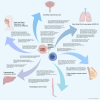Application of Immune Checkpoint Inhibitors in Cancer
- PMID: 40787068
- PMCID: PMC12335673
- DOI: 10.1002/mco2.70176
Application of Immune Checkpoint Inhibitors in Cancer
Abstract
Cancer is a significant challenge to society and public health in the 21st century. According to GLOBOCAN 2020, there were 19.3 million new cancer cases with approximately 10.0 million deaths in 2020 globally. By 2040, 28 million new cases and 16.2 million deaths are estimated. With the escalating challenges of cancer and limitations of conventional therapies like surgery, chemotherapy, and radiotherapy, the development of novel therapies such as immunotherapy and targeted therapy is required. Immunotherapy, especially immune checkpoint inhibitors (ICIs), has become a significant advancement in cancer treatment, combating tumors by activating the immune system. This review offers a thorough overview of ICIs, including their classification, mechanisms of action, and adverse events. It also examines the application of ICIs across various cancer types especially on advanced or unresectable malignancies, such as head and neck squamous cell carcinoma, esophageal cancer, non-small cell lung cancer, breast cancer, hepatocellular carcinoma, and bladder cancer, highlighting their therapeutic potential and the challenges they face. By providing a comprehensive analysis, this review aims to construct a reference system for clinicians to better understand and utilize ICIs in treating cancer.
Keywords: Advanced malignancies; Adverse events; Clinical application; Immune checkpoint inhibitors; Immune checkpoints.
© 2025 The Author(s). MedComm published by Sichuan International Medical Exchange & Promotion Association (SCIMEA) and John Wiley & Sons Australia, Ltd.
Conflict of interest statement
The authors declare no conflicts of interest.
Figures


References
-
- Bray F., Laversanne M., Sung H., et al., “Global Cancer Statistics 2022: GLOBOCAN Estimates of Incidence and Mortality Worldwide for 36 Cancers in 185 Countries,” CA: A Cancer Journal for Clinicians 74, no. 3 (2024): 229–263. - PubMed
-
- Kaur R., Bhardwaj A., and Gupta S., “Cancer Treatment Therapies: Traditional to Modern Approaches to Combat Cancers,” Molecular Biology Reports 50, no. 11 (2023): 9663–9676. - PubMed
-
- Brunet J. F., Denizot F., Luciani M. F., et al., “A New Member of the Immunoglobulin Superfamily–CTLA‐4,” Nature 328, no. 6127 (1987): 267–270. - PubMed
-
- Leach D. R., Krummel M. F., and Allison J. P., “Enhancement of Antitumor Immunity by CTLA‐4 Blockade,” Science (New York, NY) 271, no. 5256 (1996): 1734–1736. - PubMed
Publication types
LinkOut - more resources
Full Text Sources
